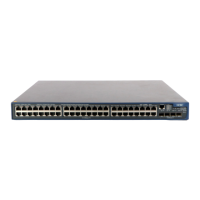4-51
keyid: MD5 authentication key ID. It ranges from 1 to 255. It must be equal to the authentication key ID
of the virtually linked peer.
key: MD5 authentication key. If you use simple text authentication key, you can input a string containing
1 to 16 characters. When you use the display current-configuration command to display system
information, the MD5 authentication key is displayed in the form of cipher text with a length of 24
characters. Inputting the key in the form of cipher text with a length of 24 characters is also supported.
Description
Use the vlink-peer command to create and configure a virtual link.
Use the undo vlink-peer command to cancel an existing virtual link.
According to RFC2328, an OSPF area must be connected to the backbone network. You can use the
vlink-peer command to keep the connectivity. Virtual link can be regarded as a common interface that
uses OSPF because the principle for configuring the parameters such as hello, retransmit, and
trans-delay on it is similar.
Considerations on parameters:
z The smaller the hello interval is, the faster the network converges and the more network resources
are consumed.
z A too small retransmission interval will lead to unnecessary retransmissions. A big value is
appropriate for a low speed link.
z You need to specify an appropriate transmission delay with the trans-delay keyword.
Note that, virtual link authentication adopts the MD5 cipher text or simple text authentication mode set
with the authentication-mode command for Area 0. Therefore, you need to specify the authentication
mode for Area 0 on both ABRs interconnected by the virtual link.
Related commands: authentication-mode, display ospf.
Examples
# Create a virtual link between Router A and Router B and use the MD5 cipher authentication mode
(The router ID of Router A is 10.1.1.1 and that of Router B is 10.1.1.2).
z Configure Router A
<RouterA> system-view
System View: return to User View with Ctrl+Z.
[RouterA] ospf 1
[RouterA-ospf-1-area-0.0.0.0] authentication-mode md5
[RouterA-ospf-1-area-0.0.0.0] quit
[RouterA-ospf-1] area 10.0.0.0
[RouterA-ospf-1-area-10.0.0.0] vlink-peer 10.1.1.2 md5 3 345
z Configure RouterB
<RouterB> system-view
System View: return to User View with Ctrl+Z.
[RouterB] ospf 1
[RouterB-ospf-1-area-0.0.0.0] authentication-mode md5
[RouterB-ospf-1-area-0.0.0.0] quit
[RouterB-ospf-1] area 10.0.0.0
[RouterB-ospf-1-area-10.0.0.0] vlink-peer 10.1.1.1 md5 3 345

